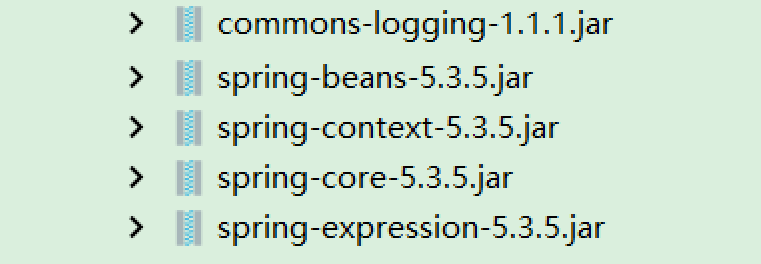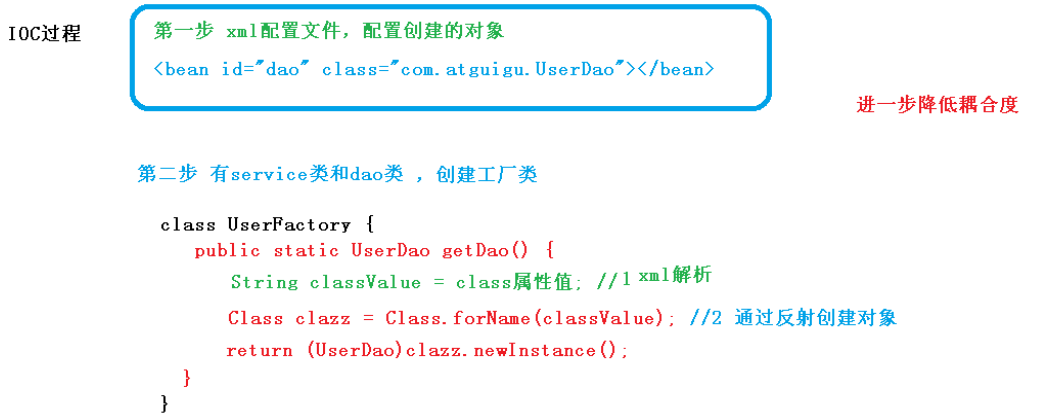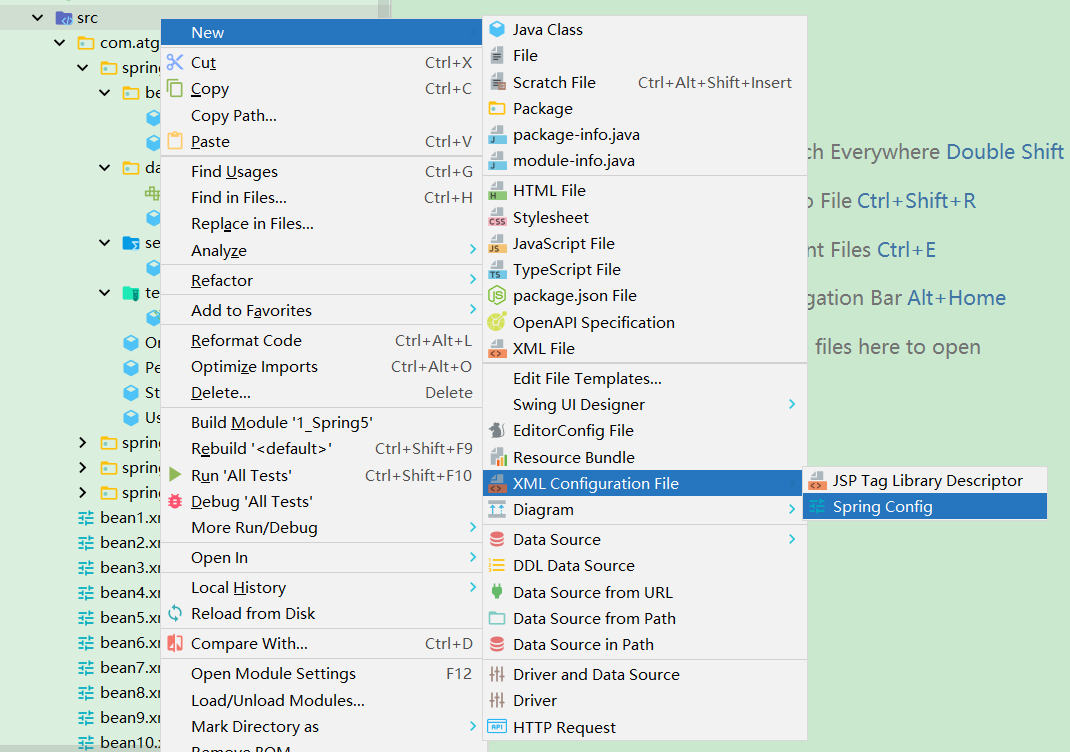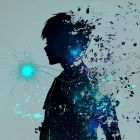一、Spring介绍
Spring 是轻量级的开源的 JavaEE 框架。Spring 可以解决企业应用开发的复杂性!
1、概述
Spring 有两个核心部分:
- IOC:控制反转,把创建对象过程交给 Spring 进行管理
- Aop:面向切面,不修改源代码进行功能增强
Spring 特点:
- 方便解耦,简化开发
- Aop 编程支持
- 方便程序测试
- 方便和其他框架进行整合
- 方便进行事务操作
- 降低 API 开发难度
2、Spring下载
下载地址,点击这里!
下载完成后解压找到lib目录,其中就是相关jar包!
SpringIOC基本包:

注意:Spring使用依赖于一个日志包,commons-logging包,为第三方包!
二、IOC概述
1、什么是IOC
IOC:(Inversion Of Control)控制反转,把对象创建和对象之间的调用过程,交给 Spring 进行管理
使用 IOC 目的:为了降低耦合度
2、IOC底层原理
三大组成部分:
- xml 解析
- 工厂模式
- 反射
原理如下方简图:

三、IOC容器两种接口
IOC 思想基于 IOC 容器完成,IOC 容器底层就是对象工厂!
Spring 提供 IOC 容器实现两种方式:(两个接口)
两种Bean创建示例:
getBean方法:参数只有Class对象时,会获取到此类的所有实现类(子类),参数也可为id值和Class对象!
1
2
3
4
5
6
7
8
9
10
11
12
13
14
15
| @Test
public void test2(){
BeanFactory context =
new ClassPathXmlApplicationContext("bean1.xml");
BeanFactory context1 = new XmlBeanFactory(new InputStreamResource(
BeanFactory.class.getResourceAsStream("bean1.xml")));
User user = context.getBean("user", User.class);
System.out.println(user);
user.hello();
}
|
ApplicationContext 接口有实现类:
- FileSystemXmlApplicationContext:加载的是配置文件在系统的全路径
C://....(一般不用)
- ClassPathXmlApplicationContext:加载的是配置文件在src下的相对路径

四、IOC操作Bean管理
Bean 管理指的是两个操作:
Bean 管理操作有两种方式:
1、基XML方式
1.1、导包

1.2、创建XML配置文件
创建方式如下:

1.3、创建对象
1
2
3
4
5
6
7
8
| <?xml version="1.0" encoding="UTF-8"?>
<beans xmlns="http://www.springframework.org/schema/beans"
xmlns:xsi="http://www.w3.org/2001/XMLSchema-instance"
xsi:schemaLocation="http://www.springframework.org/schema/beans http://www.springframework.org/schema/beans/spring-beans.xsd">
<bean id="user" class="com.atguigu.spring.User"></bean>
</beans>
|
在 spring 配置文件中,使用 bean 标签,标签里面添加对应属性,就可以实现对象创建:
创建对象时候,默认也是执行无参数构造方法完成对象创建:
若该类有有参构造器,则会发生No default constructor found(NoSuchMethodException)异常!
即底层使用反射调用构造器使用的是newInstance()方法,该方法不传参数,则默认调用无参构造器,而你有了有参构造器,则系统默认的无参构造器就失效了,所以创建构造器要有参无参一起写!或者都不写!
1.4、注入属性
注意:
1.4.1 通过set方法注入
配置文件中配置!该方法调用set方法注入,类内没有set方法会报错!
1
2
3
4
5
6
7
8
9
|
<bean id="person" class="com.atguigu.spring.Person">
<property name="name" value="itnxd"></property>
</bean>
|
1.4.2 通过有参构造注入
无需set方法和空参构造,该类不要求有无参构造器,默认会从xml配置文件读取构造器参数进行调用对应的有参构造!
- xml文件的constructor-arg标签 可以不使用name属性,但要求这些标签的顺序必须与构造器中参数的顺序一致
- 构造器重载时,可以在 constructor-arg标签 中使用type属性指定参数的类型
- 可以在 constructor-arg标签 中使用index属性指定构造器中参数的索引,从0开始
1
2
3
4
5
6
7
8
|
<bean id="order" class="com.atguigu.spring.Order">
<constructor-arg name="name" value="itnxd"></constructor-arg>
</bean>
|
1.4.3 通过p名称空间注入
即在最上方添加一行xmlns:p="http://www.springframework.org/schema/p"!
同样需要有对应属性的set方法,无需构造器!
1
2
3
4
5
6
7
8
9
10
11
12
| <?xml version="1.0" encoding="UTF-8"?>
<beans xmlns="http://www.springframework.org/schema/beans"
xmlns:xsi="http://www.w3.org/2001/XMLSchema-instance"
xmlns:p="http://www.springframework.org/schema/p"
xsi:schemaLocation="http://www.springframework.org/schema/beans http://www.springframework.org/schema/beans/spring-beans.xsd">
<bean id="stu" class="com.atguigu.spring.Stu" p:name="itnxd">
</bean>
</beans>
|
1.5、注入其他属性
1.5.1 字面量null值
虽然不设置默认为null,这里只是表示可以通过xml设置
需要有set方法和空参构造!
1
2
3
4
5
| <bean name="order1" class="com.atguigu.spring.Order">
<property name="name">
<null/>
</property>
</bean>
|
1.5.2 属性值包含特殊符号
- 把
<>进行转义 < >
- 把带特殊符号内容写到
<![CDATA[]]>
1
2
3
4
5
6
7
8
| <bean name="order2" class="com.atguigu.spring.Order">
<property name="name">
<value><![CDATA[<itnxd>]]></value>
</property>
</bean>
|
1.6、注入属性,外部bean
外部bean例子: 通过service层去调用dao层!
需要有Set方法!
1
2
3
4
5
6
7
8
9
10
11
12
13
14
15
16
17
18
19
20
21
22
23
| public class UserService {
private UserDao userDao;
public void setUserDao(UserDao userDao) {
this.userDao = userDao;
}
public void show(){
System.out.println("UserService show() ....");
userDao.update();
}
}
|
XML配置:
ref:表示引用外部的bean,通过id值引用
1
2
3
4
5
6
7
8
9
10
11
12
13
|
<bean id="userService" class="com.atguigu.spring.service.UserService">
<property name="userDao" ref="userDaoImpl"></property>
</bean>
<bean id="userDaoImpl" class="com.atguigu.spring.dao.UserDaoImpl"></bean>
|
1.7、注入属性,内部bean
与外部bean一样,只是将该bean进行了嵌套!
需要有对应属性的set方法!
Emp里有Dept对象!
1
2
3
4
5
6
7
8
9
10
11
12
|
<bean id="emp" class="com.atguigu.spring.bean.Emp">
<property name="name" value="itnxd"></property>
<property name="gender" value="boy"></property>
<property name="dept">
<bean id="dept" class="com.atguigu.spring.bean.Dept">
<property name="name" value="学生部门"></property>
</bean>
</property>
</bean>
|
1.8、注入属性,级联赋值
表示一个类中有另个一类的属性,为另一个类赋值时候,需要通过类.属性进行赋值:dept.name
1
2
3
4
5
6
7
8
9
10
11
12
13
14
15
16
17
18
19
20
21
22
23
24
|
<bean id="emp" class="com.atguigu.spring.bean.Emp">
<property name="name" value="itnxd"></property>
<property name="gender" value="boy"></property>
<property name="dept" ref="dept"></property>
</bean>
<bean id="dept" class="com.atguigu.spring.bean.Dept">
<property name="name" value="学生部门"></property>
</bean>
<bean id="emp1" class="com.atguigu.spring.bean.Emp">
<property name="name" value="itnxd"></property>
<property name="gender" value="boy"></property>
<property name="dept" ref="dept1"></property>
<property name="dept.name" value="学生部门"></property>
</bean>
<bean id="dept1" class="com.atguigu.spring.bean.Dept"></bean>
|
1.9、基于xml注入集合属性
同样需要有set方法!
- 注入数组类型属性
- 注入 List 集合类型属性
- 注入 Map 集合类型属性
- 在集合里面设置对象类型值
JavaBean类型:
1
2
3
4
5
6
7
8
9
10
| public class Stu {
private String[] str;
private List<String> list;
private Map<String, String> map;
private Set<String> set;
private List<Course> courseList;
...set方法
}
|
XML配置实现:
1
2
3
4
5
6
7
8
9
10
11
12
13
14
15
16
17
18
19
20
21
22
23
24
25
26
27
28
29
30
31
32
33
34
35
36
37
38
39
40
41
42
43
44
45
46
|
<bean id="stu" class="com.atguigu.spring1.Stu">
<property name="str">
<array>
<value>java 课程</value>
<value>数据库课程</value>
</array>
</property>
<property name="list">
<list>
<value>张三</value>
<value>小三</value>
</list>
</property>
<property name="map">
<map>
<entry key="JAVA" value="java"></entry>
<entry key="PHP" value="php"></entry>
</map>
</property>
<property name="set">
<set>
<value>MySQL</value>
<value>Redis</value>
</set>
</property>
<property name="courseList">
<list>
<ref bean="course1"></ref>
<ref bean="course2"></ref>
</list>
</property>
</bean>
<bean id="course1" class="com.atguigu.spring1.Course">
<property name="name" value="Spring5 框架"></property>
</bean>
<bean id="course2" class="com.atguigu.spring1.Course">
<property name="name" value="MyBatis 框架"></property>
</bean>
|
把集合注入公共部分提取出来:
类里为private List<String> list类型!
在 spring 配置文件中引入名称空间 util!
1
2
3
4
5
6
7
8
9
10
11
12
13
14
15
16
17
18
19
20
21
22
23
24
25
26
27
28
29
30
31
| <?xml version="1.0" encoding="UTF-8"?>
<beans xmlns="http://www.springframework.org/schema/beans"
xmlns:xsi="http://www.w3.org/2001/XMLSchema-instance"
这里添加一行:
xmlns:util="http://www.springframework.org/schema/util"
xsi:schemaLocation=
"http://www.springframework.org/schema/beans http://www.springframework.org/schema/beans/spring-beans.xsd
这里添加一行:同上方,将关键词全改为util即可!
http://www.springframework.org/schema/util http://www.springframework.org/schema/util/spring-util.xsd"
>
<util:list id="bookList">
<value>易筋经</value>
<value>九阴真经</value>
<value>九阳神功</value>
</util:list>
<bean id="book" class="com.atguigu.spring1.Book">
<property name="list" ref="bookList"></property>
</bean>
</beans>
|
2、基于注解方式
可以使用注解来简化XML配置!
2.1、导包
spring-aop-5.3.5.jar
2.2、四大创建对象的注解
Spring 针对 Bean 管理中创建对象提供注解:
- @Service:一般用于Service层
- @Controller:一般用于Web层(Servlet)
- @Repository:一般用于Dao层
- @Component:其他层次使用
上面四个注解功能是一样的,都可以用来创建 bean 实例
2.3、注解方式创建对象
- 开启组件扫描(引入context命名空间)
- 如果扫描多个包,多个包使用逗号隔开
- 在类上面添加创建对象注解(四种任意一种即可)
- 在注解里面 value 属性值可以省略不写
- 默认值是类名称,首字母小写
- 开启注解扫描细节配置
use-default-filters="false":表示现在不使用默认 filter,自己配置 filtercontext:include-filter :设置扫描哪些内容context:exclude-filter:设置不扫描那些内容expression:指定该注解是否扫描
类上添加创建对象注解:
1
2
3
4
5
|
@Service(value = "userService")
public class UserService {
}
|
XML配置:
1
2
3
4
5
6
7
8
9
10
11
12
13
14
15
16
17
18
19
20
21
22
23
24
25
26
27
28
29
30
31
32
33
34
35
36
37
38
39
40
41
42
| <?xml version="1.0" encoding="UTF-8"?>
<beans xmlns="http://www.springframework.org/schema/beans"
xmlns:xsi="http://www.w3.org/2001/XMLSchema-instance"
添加context名称空间:
xmlns:context="http://www.springframework.org/schema/context"
xsi:schemaLocation="http://www.springframework.org/schema/beans http://www.springframework.org/schema/beans/spring-beans.xsd
还有这一行:
http://www.springframework.org/schema/context http://www.springframework.org/schema/context/spring-context.xsd">
<context:component-scan base-package="com.atguigu.spring"></context:component-scan>
<context:component-scan base-package="com.atguigu.spring" use-default-filters="false">
<context:include-filter type="annotation"
expression="org.springframework.stereotype.Controller"/>
</context:component-scan>
<context:component-scan base-package="com.atguigu">
<context:exclude-filter type="annotation"
expression="org.springframework.stereotype.Controller"/>
</context:component-scan>
</beans>
|
测试:
基于注解和XML混合方式:
1
2
3
4
5
6
7
8
9
10
11
| @Test
public void test1(){
ApplicationContext context =
new ClassPathXmlApplicationContext("bean1.xml");
UserService userService = context.getBean("userService", UserService.class);
System.out.println(userService);
userService.show();
}
|
2.4、注解方式实现属性注入
2.4.1 @Autowired:根据属性类型进行自动装配
不需要添加 set 方法!
- 第一步 把 service 和 dao 对象创建,在 service 和 dao 类添加创建对象注解
- 第二步 在 service 注入 dao 对象,在 service 类添加 dao 类型属性,在属性上面使用注解
1
2
3
4
5
6
7
8
9
10
11
| @Repository
public class UserDaoImpl implements UserDao{
}
@Service
public class UserService {
@Autowired
private UserDao userDao;
}
|
2.4.2 @Qualifier:根据名称进行注入
这个@Qualifier 注解的使用,一定要和上面@Autowired 一起使用!
相当于一步步缩小范围来唯一确定,Autowired通过类型缩小范围,Qualifier再通过名称唯一确定!
1
2
3
4
5
6
7
8
9
10
11
12
| @Repository(value = "userDaoImpl_1")
public class UserDaoImpl implements UserDao{
}
@Service
public class UserService {
@Autowired
@Qualifier(value = "userDaoImpl_1")
private UserDao userDao;
}
|
2.4.3 @Resource:可以根据类型注入,可以根据名称注入
jdk11及以上已经移除该包!
需要引入:import javax.annotation.Resource;
javax为拓展包,需要去下载导入该包javax.annotation-api-1.3.2.jar
下载地址:https://mvnrepository.com/artifact/javax.annotation/javax.annotation-api
关于Resource介绍:

总结:
- 默认byName,也可byType
- 指定name属性,则为byName
- 指定type属性,则为byType
- 同时指定name和type,则可唯一匹配
1
2
3
4
5
6
7
8
9
10
11
12
13
14
| @Repository(value = "userDaoImpl_1")
public class UserDaoImpl implements UserDao{
}
@Service
public class UserService {
@Resource
private UserDao userDao;
}
|
2.4.4 @Value:注入普通类型属性
1
2
| @Value("abc")
private String name;
|
3、完全注解开发
创建配置类,实现完全注解开发,摆脱XML方式!
@Configuration:表名是一个配置类@ComponentScan(basePackages = {"com.atguigu.spring"}):替代XML开启组件扫描,basePackages指定扫描包路径
配置类:
1
2
3
4
5
| @Configuration
@ComponentScan(basePackages = {"com.atguigu.spring"})
public class SpringConfig {
}
|
测试:
1
2
3
4
5
6
7
8
9
10
| @Test
public void test2(){
ApplicationContext context =
new AnnotationConfigApplicationContext(SpringConfig.class);
UserService userService = context.getBean("userService", UserService.class);
System.out.println(userService);
userService.show();
}
|
五、Spring两种Bean
1、普通Bean
在配置文件中定义 bean 类型就是返回类型
2、工厂FactoryBean
在配置文件定义 bean 类型可以和返回类型不一样!
- 第一步 创建类,让这个类作为工厂 bean,实现接口 FactoryBean
- 第二步 实现接口里面的方法,在实现的方法中定义返回的 bean 类型
1
2
3
4
5
6
7
8
9
10
11
12
13
14
15
16
17
18
19
| public class MyBean implements FactoryBean<Course> {
@Override
public Course getObject() throws Exception {
Course course = new Course();
course.setName("course");
return course;
}
@Override
public Class<?> getObjectType() {
return null;
}
@Override
public boolean isSingleton() {
return false;
}
}
|
XML:
1
2
3
4
5
6
7
8
| <?xml version="1.0" encoding="UTF-8"?>
<beans xmlns="http://www.springframework.org/schema/beans"
xmlns:xsi="http://www.w3.org/2001/XMLSchema-instance"
xsi:schemaLocation="http://www.springframework.org/schema/beans http://www.springframework.org/schema/beans/spring-beans.xsd">
<bean id="myBean" class="com.atguigu.spring2.MyBean"></bean>
</beans>
|
测试: 返回类型不一定是MyBean!
1
2
3
4
5
6
7
8
9
10
| @Test
public void test13(){
ApplicationContext context =
new ClassPathXmlApplicationContext("bean7.xml");
Course course = context.getBean("myBean", Course.class);
System.out.println(course);
}
|
六、Bean作用域
1、Bean属性Scope
在 Spring 里面,默认情况下,bean 是单实例对象,我们可以通过scope属性来设置单例还是多例!
scope 属性值:
- singleton,表示是单实例对象
- prototype,表示是多实例对象
注意:
- 设置 scope 值是 singleton 时候,加载 spring 配置文件时候就会创建单实例对象
- 设置 scope 值是 prototype 时候,不是在加载 spring 配置文件时候创建 对象,在调用 getBean 方法时候创建多实例对象
- scope:也可以是session和request(意思同javaWeb)
1
| <bean id="book" class="com.atguigu.spring1.Book" scope="prototype"></bean>
|
七、Bean生命周期
1、五步
- 通过构造器创建 bean 实例(无参数构造)
- 为 bean 的属性设置值和对其他 bean 引用(调用 set 方法)
- 调用 bean 的初始化的方法(需要进行配置初始化的方法)
- bean 可以使用了(对象获取到了)
- 当容器关闭时候,调用 bean 的销毁的方法(需要进行配置销毁的方法)
演示:
1
2
3
4
5
6
7
8
9
10
11
12
13
14
15
16
17
18
19
20
21
22
23
24
| public class Order {
private String name;
public Order() {
System.out.println("1. 执行无参构造创建bean实例");
}
public void setName(String name) {
this.name = name;
System.out.println("2. 调用set方法设置属性值");
}
public void initMethod(){
System.out.println("3. 调用初始化方法");
}
public void destroyMethod(){
System.out.println("5. 执行销毁的方法");
}
}
|
1
2
3
4
5
6
7
8
9
10
11
12
13
14
| @Test
public void test15(){
ApplicationContext context =
new ClassPathXmlApplicationContext("bean9.xml");
com.atguigu.spring2.Order order = context.getBean("order", com.atguigu.spring2.Order.class);
System.out.println("4. 获取到bean对象创建的实例");
System.out.println(order);
((ClassPathXmlApplicationContext) context).close();
}
|
XML配置初始化和销毁方法:
1
2
3
4
|
<bean id="order" class="com.atguigu.spring2.Order" init-method="initMethod" destroy-method="destroyMethod">
<property name="name" value="itnxd"></property>
</bean>
|
2、七步
bean 的后置处理器,bean 生命周期有七步:初始化前后各一个(第三步和第五步)
- 通过构造器创建 bean 实例(无参数构造)
- 为 bean 的属性设置值和对其他 bean 引用(调用 set 方法)
- 把 bean 实例传递 bean 后置处理器的方法 postProcessBeforeInitialization
- 调用 bean 的初始化的方法(需要进行配置初始化的方法)
- 把 bean 实例传递 bean 后置处理器的方法 postProcessAfterInitialization
- bean 可以使用了(对象获取到了)
- 当容器关闭时候,调用 bean 的销毁的方法(需要进行配置销毁的方法)
添加后置处理器:
- 创建类,实现接口 BeanPostProcessor,创建后置处理器
- 配置xml文件,该文件中的bean都会默认使用这个后置处理器!
1
2
3
4
5
6
7
8
9
10
11
12
13
14
| public class MyBeanPost implements BeanPostProcessor {
@Override
public Object postProcessBeforeInitialization(Object bean, String beanName) throws BeansException {
System.out.println("在初始化之前执行的postProcessBeforeInitialization方法!");
return null;
}
@Override
public Object postProcessAfterInitialization(Object bean, String beanName) throws BeansException {
System.out.println("在初始化之后执行的postProcessBeforeInitialization方法!");
return null;
}
}
|
1
2
|
<bean id="myBeanPost" class="com.atguigu.spring2.MyBeanPost"></bean>
|
八、XML自动装配
根据指定装配规则(属性名称或者属性类型),Spring 自动将匹配的属性值进行注入!
通过bean 标签属性 autowire,配置自动装配:
- byName 根据属性名称注入 ,注入值 bean 的 id 值和类属性名称一样
- byType 根据属性类型注入,只能有一个对应beanId
1
2
3
4
5
6
7
8
9
10
11
12
|
<bean id="emp" class="com.atguigu.spring3.Emp" autowire="byName"></bean>
<bean id="dept" class="com.atguigu.spring3.Dept"></bean>
|
九、XML外部属性文件
以使用XML配置Druid数据库连接池举例:
先导入druid的包!
1、直接配置
1
2
3
4
5
6
| <bean id="dataSource" class="com.alibaba.druid.pool.DruidDataSource">
<property name="driverClassName" value="com.mysql.cj.jdbc.Driver"></property>
<property name="url" value="jdbc:mysql://localhost:3306/test"></property>
<property name="username" value="root"></property>
<property name="password" value="xxx"></property>
</bean>
|
2、引入外部属性文件
通过src目录下新建jdbc.properties配置文件然后使用XML进行读取!
注意:
- classpath 对应 src目录下
- 需要引入context名称空间
jdbc.properties:
1
2
3
4
| prop.driverClass=com.mysql.cj.jdbc.Driver
prop.url=jdbc:mysql://localhost:3306/test
prop.userName=root
prop.password=xxx
|
XML文件:
1
2
3
4
5
6
7
8
9
10
11
12
13
14
15
16
17
18
19
20
21
| <?xml version="1.0" encoding="UTF-8"?>
<beans xmlns="http://www.springframework.org/schema/beans"
xmlns:xsi="http://www.w3.org/2001/XMLSchema-instance"
引入context名称空间:
xmlns:context="http://www.springframework.org/schema/context"
xsi:schemaLocation="http://www.springframework.org/schema/beans http://www.springframework.org/schema/beans/spring-beans.xsd
加入以下这一行,关键词全改为context
http://www.springframework.org/schema/context http://www.springframework.org/schema/context/spring-context.xsd
">
<context:property-placeholder location="classpath:jdbc.properties"></context:property-placeholder>
<bean id="dataSource" class="com.alibaba.druid.pool.DruidDataSource">
<property name="driverClassName" value="${prop.driverClass}"></property>
<property name="url" value="${prop.url}"></property>
<property name="username" value="${prop.userName}"></property>
<property name="password" value="${prop.password}"></property>
</bean>
</beans>
|









